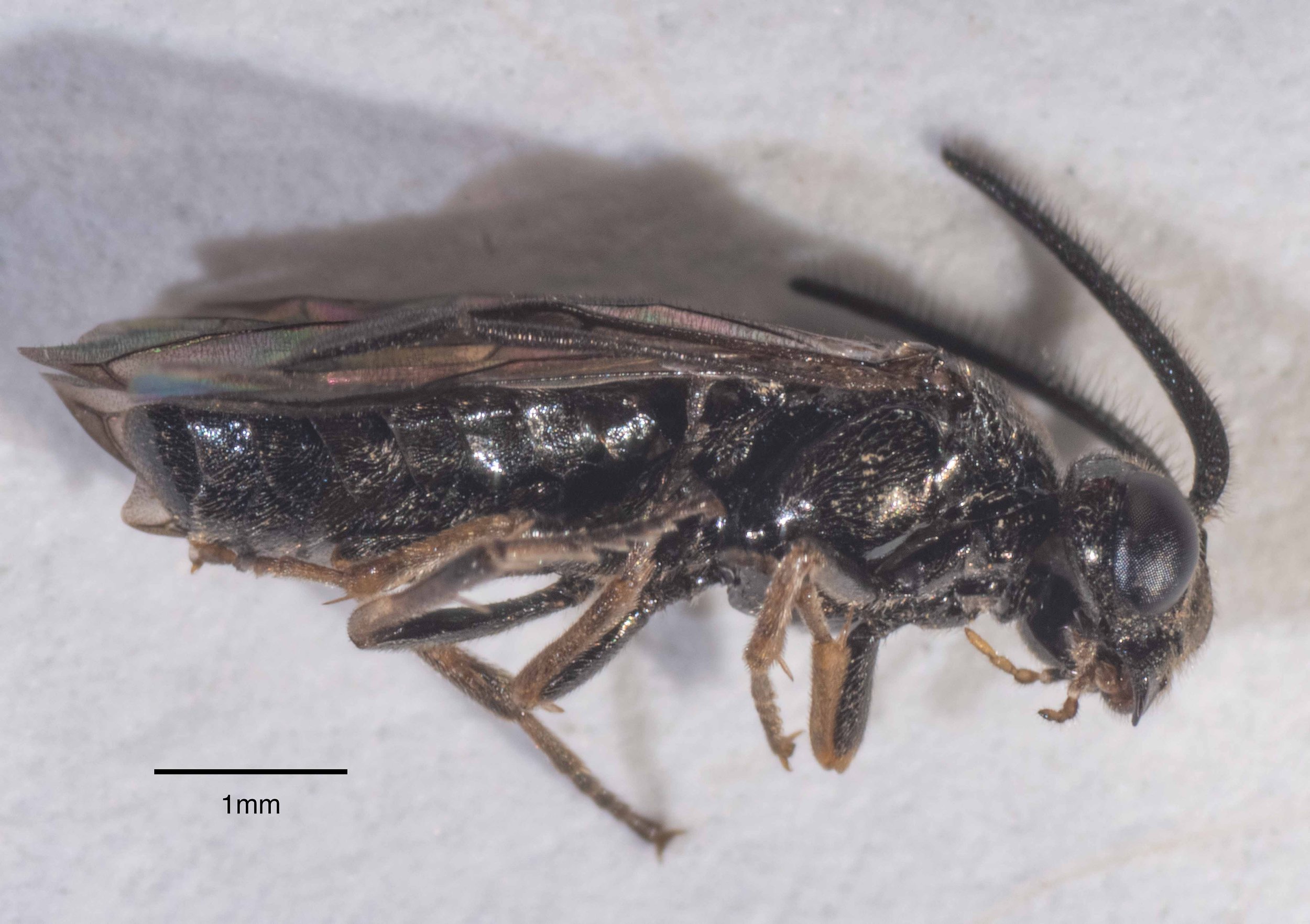Antargidium nigrum (Argidae: Arginae)

Workbook
Observations on a male specimen of Antargidium nigrum received from Kerry Stuart. Collected on 12th October 2024 at Creyk Park, WA.
Features of this specimen are compared to the original description and photo (image alongside) of Antagidium nigrum (Schmidt, 2012) as well as those diagnostic for the genus Antargidium (marked with +) as given by Morice (1919) and Benson (1963).
Antargidium nigrum female holotype - from Schmidt et al (2012) Fig. 12
Female body length 6-7mm (this male 5.9mm)
Head and thorax black, abdomen dark brown to black (black in this male)
Tegula, tibiae of fore and middle leg, and hind tibia at base whitish
+Middle and hind tibiae with spines before as well as at their apices
+Head with trans-orbital carina, from edge of frontal area in front of lateral ocellus towards eyes
+Antennae only 3-jointed - all joints beyond the two short basal ones fused together
+Insertion of antennae between eyes, never below them
Antennae of male much more pilose than those of female (compare middle photo in panel above with antennae of female holotype specimen above). Note that Schmidt et al (2012) make no mention of the pilose antenna of the male in their description of this species. They simply say “apart from sex related differences, similar to female in structure and colour”. I have found no mention of a pilose antenna is species descriptions of other Arginae. However it is a notable feature of the furcate (bifid) antennae of male Trichorchachus - see this iNaturalist observation and this one - and Styphelarge abdominalis.
Notes from Benson 1938 about features of Argidae
Middle tibia with two preapical spines ; anal cell of fore-wing with oblique cross-vein ; hind-wing with anal cell absent and only one enclosed middle cell, the cubital ; cenchri small so that the distance between them is almost the same as the breadth of one. [Male flagellum simple, female subclavate; mandible (fig. 25). Australian. Genus : Zenarge Rohwer. . ZENARGINAE
Intercostal vein present in fore-wing ; male antenna with flagellum not bifid; female antenna subclavate ; labium shorter than head ; mandibles usually without inner teeth beyond the basal lobe (fig. 24). Holarctic, S. American, Ethiopian, Oriental and Australian. Genera : Antargidium Morice, Arge Schrank, Scobina Lep., Stelidarge Konow, Triarge Forsius . ARGINAE
Intercostal vein absent in fore-wing; male antennae with the flagellum bifid, female spindle-shaped; labium in some species extended so that it is longer than the head (fig. 21) ; right mandible with small subapical teeth (fig. 26). W. Australian. Genus : Trichorhachus Kirby TRICHORHACHINAE
Notes from Ross 1938 about Argidae
Antennae: filiform and setaceous.—This is the common type found in most of the sawflies. The number of segments may vary from six in the Acorduleceridae, fig. 95, to thirty or more in the Pamphiliidae, fig. 88. An interesting deviation from the setaceous type is found in the Argidae, Xyelidae, and Blasticotomidae. The third segment has become greatly lengthened and thickened, and the remaining apical segments are either absent (Argidae, fig. 97), reduced to a small stub (Blasticotomidae, fig. 96) or form a slender, segmented filament (Xyelidae, figs. 86, 87).
Furcate.—The males of some genera of the Argidae have undergone a further modification of the enlarged third segment, which is divided longitudinally for almost its entire length, forming two slender filaments which are usually somewhat curled and harp-shaped, fig. 98.
1.Males …2
Females. …4
2. Third antennal segment furcate for its entire length, fig. 98................ 6
Third antennal segment entire, fig. 97 …3
3. Hind wing with cell R1 closed at apex as in fig. 218.............. Arge (pt.)
Hind wing with cell R1 open at apex as in fig. 214.......... Atomacera (pt.)
4. Both front and hind wings with cell R1 closed at apex, fig. 218...Arge (pt.)
At least hind wing with cell R1 open at apex, fig. 214......... 5
5. Tarsal claws bent over at nearly a right angle, just below middle, fig. 215,
and with the base forming a wide tooth..............: Atomacera (pt.)
Tarsal claws not bent much, and only towards apex, the base narrow, not
forming 4 tooth, figs 216.217 … 6
6. Head wide and shallow, without a raised crest between antennae,…Lyrola
Head not so wide but deeper, with a raised crest between antennae,…Sterictiphora
Sterictiphora Billberg
Characteristics. —Flagellum clavate in female, lyriform in male, fig. 98.
Head with distinct, carinate crest between antennal sockets. Front wings
with cell R, either open or closed at apex, hind wing with this cell open
and vein 2A various.
Hind wing with anal cell much longer than its apical petiole,…Sterictiphora






















